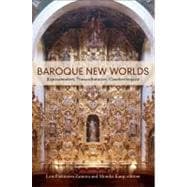
Note: Supplemental materials are not guaranteed with Rental or Used book purchases.
Purchase Benefits
What is included with this book?
| Illustrations | p. xi |
| Acknowledgments | p. xiii |
| ôBaroque, New World Baroque, Neobaroque: Categories and Concepts | p. 1 |
| Representation: Foundational Essays on Baroque Aesthetics and Ideology | |
| The European Baroque | |
| Editors' Note to Chapter One | p. 41 |
| ôOn the Baroqueö (1878) | p. 44 |
| Editors' Note to Chapter Two | p. 46 |
| Excerpt from the Introduction to Principles of Art History: The Problem of the Development of Style in Later Art (1915) | p. 49 |
| Editors' Note to Chapter Three | p. 55 |
| Excerpts from The Origin of German Tragic Drama (1928) | p. 59 |
| Editors' Note to Chapter Four | p. 75 |
| Excerpts from ôThe Debate on the Baroque in Pontignyö (1935) | p. 78 |
| Editors'Note to Chapter Five | p. 93 |
| Excerpts from ôThe Concept of Baroque in Literary Scholarshipö (1945, rev. 1962) | p. 95 |
| Editors' Note to Chapter Six | p. 115 |
| ôBaroque in Englandö (1960) | p. 119 |
| Editors' Note to Chapter Seven | p. 136 |
| Chapter 2 from La folie du voir, ôThe Work of the Gazeö (1986) | p. 140 |
| The New World Baroque and the Neobaroque | |
| Editors' Note to Chapter Eight | p. 161 |
| Excerpt from ôSavoring Góngoraö (1928) | p. 165 |
| Editors' Note to Chapter Nine | p. 179 |
| Chapter 1 from Redescubrimiento de América en el arte, ôAmerica's Relation to Europe in the Artsö (1936) | p. 183 |
| Editors' Note to Chapter Ten | p. 198 |
| ôThe Baroque in Americaö (1940) | p. 200 |
| Editors' Note to Chapter Eleven | p. 209 |
| Chapter 2 from La expresión americana, ôBaroque Curiosityö (1957) | p. 212 |
| Editors' Note to Chapters Twelve and Thirteen | p. 241 |
| ôThe City of Columnsö (1964) | p. 244 |
| Excerpt from ôQuestions Concerning the Contemporary Latin American Novelö (1964) | p. 259 |
| Editors' Note to Chapters Fourteen and Fifteen | p. 265 |
| ôThe Baroque and the Neobaroqueö (1972) | p. 270 |
| Chapter 3 from Barroco, ôBaroque Cosmology: Keplerö (1974) | p. 292 |
| Editors' Note to Chapter Sixteen | p. 316 |
| ôThe Rule of Anthropophagy: Europe under the Sign of Devorationö (1981) | p. 319 |
| Transculturation: Colonial Practice | |
| "Góngora in Spanish American Poetry, Góngora in Luso-Brazilian Poetry: Critical Parallels" | p. 343 |
| ôSor Juana and Luis de Góngora: The Poetics of Imitatioö (2006) | p. 352 |
| ôAmerican Baroque Histories and Geographies from Sigüenza y Góngora and Balbuena to Balboa, Carpentier, and Lezamaö | p. 394 |
| ôBaroque Quixote: New World Writing and the Collapse of the Heroic Idealö | p. 415 |
| ôBaroque Self-Fashioning in Seventeenth-Century New Franceö | p. 450 |
| ôThe Fold of Difference: Performing Baroque and Neobaroque Mexican Identitiesö | p. 467 |
| Counterconquest: Postcolonial Positions | |
| Chapter 2 from Ensayo de contraconquista, ôFrom the Baroque to the Neobaroqueö (2001) | p. 487 |
| Chapter 1 from Barroco y modernidad, ôThe Baroque at the Twilight of Modernityö (2000) | p. 508 |
| Editors' Note to Chapter | p. 529 |
| ôThe Novel as Tragedy: William Faulknerö (1970) | p. 531 |
| ôGóngora's and Lezama's Appetitesö (1978) | p. 554 |
| ôEurope and Latin America in José Lezama Limaö | p. 571 |
| ôSeeking a Cuba of the Self: Baroque Dialogues between José Lezama Lima and Wallace Stevensö | p. 597 |
| Editors' Note to Chapter Twenty-nine | p. 622 |
| ôConcerning a Baroque Abroad in the Worldö (1990) | p. 624 |
| Bibliography | p. 627 |
| Notes on Contributors | p. 645 |
| Index | p. 651 |
| Table of Contents provided by Ingram. All Rights Reserved. |
The New copy of this book will include any supplemental materials advertised. Please check the title of the book to determine if it should include any access cards, study guides, lab manuals, CDs, etc.
The Used, Rental and eBook copies of this book are not guaranteed to include any supplemental materials. Typically, only the book itself is included. This is true even if the title states it includes any access cards, study guides, lab manuals, CDs, etc.